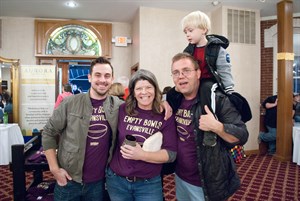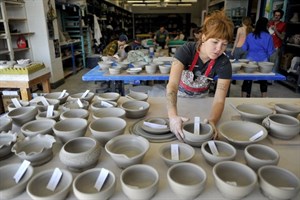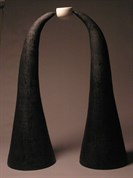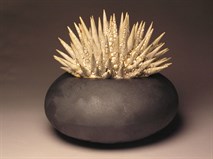
When Alisa (Al) Holen arrived at the University of Southern Indiana in 2011, she brought more than a standard curriculum; she brought an event, and a highly successful one at that. She introduced her students and the University to Empty Bowls, a national fundraising event designed to fight hunger by crafting and selling ceramic bowls and donating the proceeds to local charities. Holen added the event as a Service Learning component for her ceramics classes and invited University employees and community groups in to participate in building bowls. The annual event has quickly become a favorite with eager novice potters lining up to tap into their creativity, and loyal supporters lining up to buy a one-of-a-kind bowl and support a local cause.
I sat down with Al to discuss Empty Bowls and to get to know the woman behind the potter’s wheel.
Let’s talk about the success of Empty Bowls
When we were at Kirby’s, it was almost twice the square footage of our former space, but it was so packed that you couldn’t move. It was a madhouse, but it was exciting. A thousand bowls was really ambitious this year. We had four more groups than we had last year, so it meant I’d have a group in the studio making bowls on Monday, teach all day on Tuesday, a group in the studio Wednesday, teach all day Thursday and a group on Friday. Having a group in the studio is one thing, but then the next day you have to trim all those bowls. I did a couple of 12-hour trimming days.
 Are you surprised that it’s reached the capacity that it has?
Are you surprised that it’s reached the capacity that it has?
Oh my God, yeah, and fast. That first year with the 500 bowls, it was still really impressive. But the next year the floodgates opened and we had people waiting in line, I was just floored. Then this year, in June I started having people calling me and saying, “Hey we want to get a group in,” as opposed to the first year when I was like, “please come help us.”
I’ve never been disappointed in an Empty Bowls event. I believe in the charities and the structure of it all. I get a lot of people who tell me it’s been on their bucket list to learn how to throw pottery and I just love that I get to give them that opportunity. There’s a lot of advertising that happens word of mouth because it’s a fun experience.
How is Empty Bowls funded?
We are still operating with the grant money that was given to us the first year. Basically, I put all that money into our operating expenses and then I take it out again after the event, so we’ve been cycling the same $600. Clay is cheap, which is a bonus.
What has been the feedback from the students participating in the event?
The students are the heart and soul of this thing, as much as I organize and put it together, I couldn’t pull it off without them. The students step up and a week after they learn how to throw, they’re teaching other people how to throw.
 What is most gratifying about this event?
What is most gratifying about this event?
For me, the most gratifying thing is seeing my students’ skill levels improve by leaps and bounds, and the satisfaction they get from that. It’s a 300 level course with no prerequisite, so you get some students coming in who think they are awful at art. I tell them not to think of it as art, but to think to think of it as skill building. We’re going to skill build and then the art will happen. You have to have some skills before you conceptualize. They become more confident, more comfortable with the material and are willing to experiment.
What is the most unusual bowl ever made?
I think that I bought the best bowl at Empty Bowls this year. It was a Girl Scout’s bowl. I made a whole bunch of bisque molds, round molds that they can put the slab into and then they can underglaze it and decorate it while it’s still in the mold. Works like a charm and we get some nice bowls out of the deal.
While I was doing the demonstration, this kid just starts pinching the clay and I said “You know we have these bisque molds.” And she said “No, I’ve done this before. I know what I’m doing.” So I said “Ok, well that’s cool. You go with it.” It wound up being this flat plate with really raunchy, gnarly edges.
Then I was teaching them sgraffito, where you put the color down and etch through it. She evidently didn’t know that, so she watched then went over to her bowl. I asked, “How’s it going?” She said, “I got this, I’m making a chicken.” With zero hesitation, (and it’s off the picture plane, which is kind of a sophisticated thing), she makes this big chicken head, she sgraffitoed it, and it turned out awesome. I bought it.
What influenced you to become an artist?
That’s pretty easy. My dad, Norman D. Holen, was an art professor. He taught ceramics, sculpture and drawing. He’s a sculptor through and through. We would go to campus sometimes on a Saturday if he had to finish something up, and he would take his little daughter along. I was 10 or 11 and there was a guy there throwing mugs. I was mesmerized. I said, “I’m going to do that.” I got on the wheel the next time we visited and it’s always felt right to me.
Growing up, I didn’t know dads watched football on the weekends. I thought dads went to studios on the weekends. That was just kind of a natural rhythm of life. When my dad would be working at home, he would have his big sculpture and I’d have my little sculpture next to him. There was always clay in the home.
What drew you to teach?
I wanted to be a studio potter, so I built a studio in my basement, but I was lonely and miserable. When I found a studio in the community, people started asking if I taught classes and I said, “No, but I guess I could.” So I signed up with the community center to teach some throwing classes. We were doing some raku pots, and then it all just clicked. It was so much fun and amazing how satisfying it was to see people’s skills get better. The minute I did it, I knew I loved it. It was a no brainer from there.
 One of the things I love about your work is that it is balanced but always seems to be teetering on this dangerous edge.
One of the things I love about your work is that it is balanced but always seems to be teetering on this dangerous edge.
What inspires me the most in my work are relationships with faculty and students, husbands and wives or friends and colleagues. There are these nuances in relationships that are interesting, and I’m not necessarily good at articulating those, but I can put them into my work. If I’m having a really tense issue with somebody, I can build that into something and I know what it’s about but no one else does. There are so many metaphors that can be built with relationships and forms using a visual vocabulary.
 You also use spiky edges a lot in your work. Is that also a commentary about relationships?
You also use spiky edges a lot in your work. Is that also a commentary about relationships?
The spikes came about in a very pure and funny way. When I was in Nebraska, I was working doing functional work, but I wanted it to be more purposeful and also awkward. I love bringing awareness to the use of something. At the time my husband was eating too much butter and I was telling him “It’s going to kill you.” So I made this big butter dish and it started a conversation about overlooked functional pieces in our lives – salt and pepper shakers, butter dishes – and I thought, “I’m not going to let anyone overlook it.” I was playing with this idea of these big butter dishes and I thought “how do you keep someone from using that butter?” so then the spikes went on. The message of it being you really need to think about how much you want it before you make that commitment.
The spikes came about there, but I also realized from the whole relationship thing that my work tends to have this soft voluptuousness. It’s round, very often inflated, and there’s something really fun about having those spikes right next to those pieces. They are polar opposites but visually they work really well together.
(See more images of Holen's work in Campus Snapshots.)
The person behind the art
What was the first record/cassette/CD that you bought?
Sir Duke, by Stevie Wonder on a 45 LP.
Fill in the blank: When people look at me, they would never guess that I _____________.
Played Rugby for 13 years; am a Type 1 diabetic; like to wear dresses.
What do you miss most about being a kid?
Everything. But mostly unstructured “play time,” without guilt. I think that’s missing in most adult lives. Play of any kind refreshes my soul, but with so much to do, it’s hard to play without feeling like I should be doing something else. Any more, if we do play, it is scheduled and planned. But man… there was nothing like having a couple of friends with roller skates or a jump rope and just goofing off. We would be so creative, and just imagine we were in a circus, or winning the Olympic roller skating challenge, or climbing Mt. Everest, or building a fort, or whatever. It was just unstructured fun.
Where can people see your work locally?
In the “Solid Gold: Art Department Goes on Record” exhibit at the McCutchan Art Center and Pace Galleries, the Arts Council of Southwestern Indiana and New Harmony Contemporary Galley.